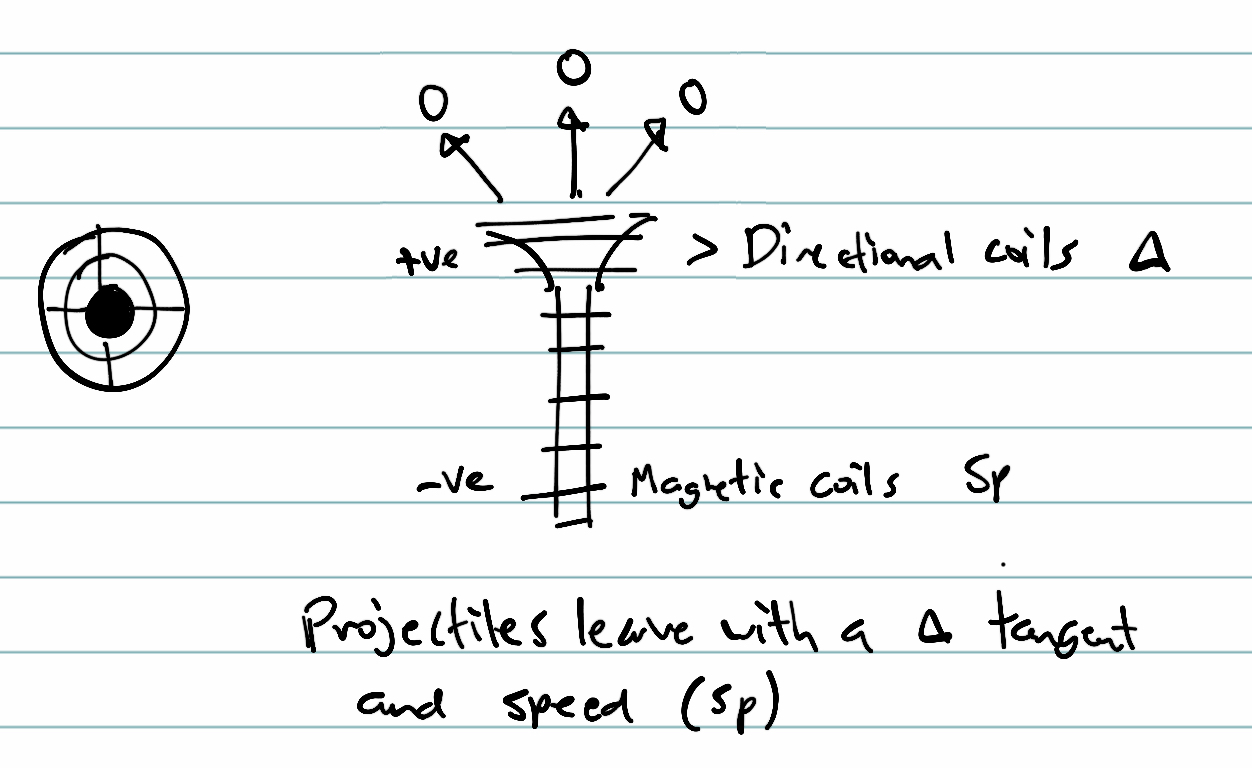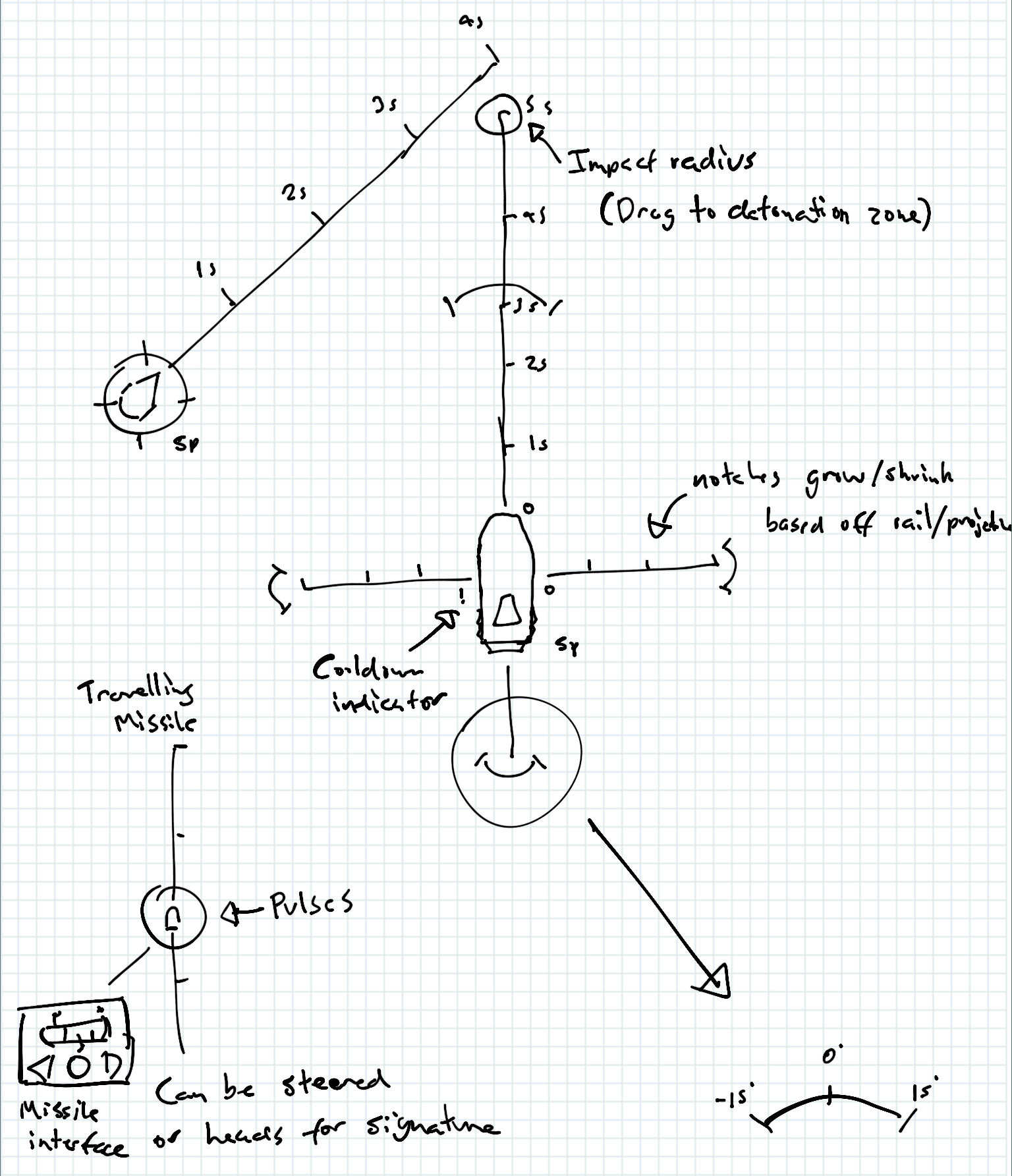
So I have spent a good amount of time pondering on how firing mechanics might work in space. Origonally I had some wild ideas like a moving rail which I scrapped as I felt it would alter the ship too much, cause some structural and mechanical issues and just wasn't great.
What I did come up with is this:

This is the 'Blunderbus rail' basically I kept the origional magnetic coil launch system but added a wide exit with coils that would attract the projectile towards a specific direction. This way are arent stuck fireing a projectile at the same direction that the ship is. The real reason this is useful is that shooting in space is complex! Mainly because of one thing: inertia.
Shooting from a sinper rifle is easy in theory, you are at a stationary point shooting at a target that is either stationary or moving at a predictable vector. You just have to consider where the target will be when the bullet crosses its path (and also gravity and wind which fortunately we dont!)
The problem is that we are moving, so we have to take the intertia of the ship acting on the projectile into account too, which makes things way way harder (like sniping from a moving truck to another moving truck going a different way). This was the main reason I made the rail as it could give us an excuse to not have to worry so much about this factor since we can change the tangent of the projectile the last second from it leaving the rail (and also say that the computer is handling this automatically). This might or might not be a factor, I actually need to think about the math a bit more.
I did up a mockup of a 2d interface for shooting in space:

Apologies for my illegable scribbles
I need to work on this more I think, but this interface would show the fireing lines that the ship has as well as letting us modify the angle that we are firing at while also showing where a projectile will be after X seconds (and also where a targeted enemy will be too). This is just me spitballing currently, building an interface is one thing. Doing the math and thinking if it will work in the scenereos we will setup is another.
Some notes:
- The notches represent 1 second of travel time this should give us a good idea of when to fire. This will dynamically chage on the interface depending on the power of the rail and the projectile type (as some have boosters or are lighter and thus accellerate quicker)
- The front rail is the longest and thus gives the most accelleration to the projectile, this is by design and mainly because we want those projectiles to be hard to catch up to and run into us.
- Projectiles can be steered (given they have that module and are not just dumb mass) after fired and will need to be shown and given an interface for that.
- I am not sure how enemy ships will show up but knowing where they are is only one peice of the puzzle, we need to know their tangent and speed too.
- This is only 2d, if the system cant work in 2d there is no way it will work in 3d. We can keep it 2d and have a top and side view and the computer can let us know when a predicted ship will cross our firing line?
I will be exapnding on this, on the trian atm so just jotting everything down for now, will clean it up later. This is just spitballing but the more I dwell on this the more complex it gets and really I don't want it too. We should always try to follow KISS where possible and then expand from there. I want to spend some free time in photoshop mocking something a bit cleaner up but I would like someone to take a think on where I am going and let me know if it is way off (or conflicts with something else, or is too complex, or is not fun).
Comments
Speed of the launch vessel
Nice analysis. On the subject of inertia, I thought I'd also add a throught on momentum (more math!).
The vessel's momentum will be added to the projectile's launch velocity, ie:
Projectile's velocity (VP) will be the launch vessel's speed (S) plus the velocity imparted by the launch mechanism (VL): VP = S + VL
Acceleration can then further be added by the projectiles own propulsion system.
This may have tactical implications as the faster the launch vessel is going at launch the greater the projectile's velocity - making it harder for a target to escape (and increasing the kinetic energy of the projectile if it should hit).






